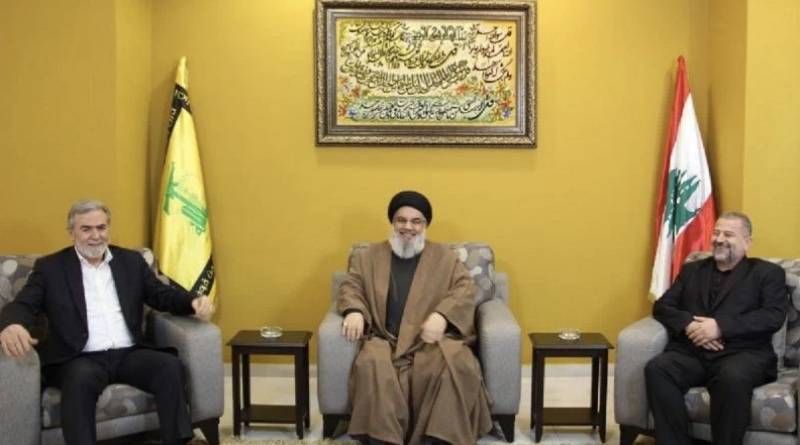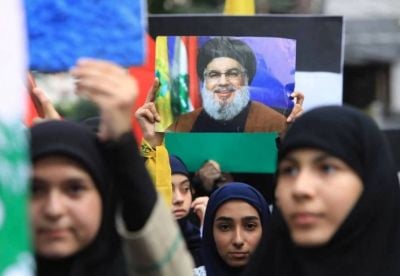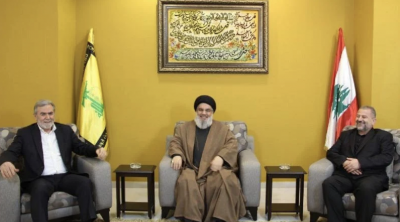
Hezbollah Secretary-General Hassan Nasrallah receiving Hamas No. 2 Saleh al-Arouri and Islamic Jihad leader Ziad Nakhala in Beirut in May. (Credit: NNA)
Hamas’s Saturday offensive in Israel was months in planning in the Lebanese capital, L’Orient-Le Jour has learned from several sources within the “axis of resistance” (i.e., the Quds Brigades, Hezbollah, Hamas and Islamic Jihad).
“The idea of infiltrating Israeli settlements had been brewing in the minds of Hezbollah leaders for years,” a member of the pro-Iran camp told our newspaper.
Hezbollah Secretary-General Hassan Nasrallah has repeatedly spoken of plans for his fighters to enter Galilee and control areas presently in Israeli state territory.
However, the source said, it was mainly in 2021, after Hamas’s “Sword of Jerusalem” operation — in which it fired more than 150 rockets into Israel after a deadline it had given Israeli forces to leave the Haram al Sharif mosque site and Sheikh Jarrah in Jerusalem expired unmet — that Iran and its allies decided that the next battles should take place within Israeli territory.
Sources L’Orient-Le Jour spoke to said that in this regard, in recent weeks, a series of meetings took place between Hezbollah, Hamas, Islamic Jihad, and Iranian military officials, including Ismail Qaani, commander of the Quds Brigades of Iran’s Islamic Revolutionary Guard Corps.
These discussions aimed to prepare an operation of this kind, the sources continued, adding that among the explored options were infiltrations into Israeli localities by Hezbollah from southern Lebanon, by Hamas and Islamic Jihad from the Gaza Strip, and even from within the West Bank.
According to the sources, contacts intensified in April. Some of these meetings were disclosed to the media at the time, such as one held between Nasrallah, Hamas deputy leader Saleh al-Arouri and Islamic Jihan lead Ziad al-Nakhala.
At this meeting, the three reviewed the outcome of the Megiddo operation executed in March when a fighter infiltrated northern Israel from Lebanon, L’Orient-Le Jour’s sources said, explaining that the operation served as a test to evaluate the permeability of Israeli defenses and to identify vulnerabilities.
It was within this context that Hezbollah organized a full-scale, public military demonstration in the village of Aaramta in southern Lebanon, titled “We Will Cross,” signaling its intention to change the current rules of engagement and shift the clashes to territories controlled by the Israeli state.
The “Al-Aqsa Flood” operation was prepared in a joint Hamas-Hezbollah-Iran military operations room in Beirut over several months, a source affiliated with this axis revealed, specifying that meetings intensified in recent weeks to execute the plan.
According to several sources, the plan included a cyberattack aimed at weakening Israeli ground and air defense systems, before the launching of two attacks simultaneously: one by air with paratroopers and the other with booby-trapped drones.
Finally, these sources said, a ground incursion would be made to breach the iron barrier between Gaza and settlements in southern Israel. Approximately 1,000 Hamas fighters participated in implementing this plan, positioning themselves at specific points along the barrier and penetrating it simultaneously, while the assault was accompanied by air support, they added.
This operational mode follows the main points of the strategy presented by Hezbollah during its public military exercises in Aaramta, which included the use of motorcycles and undercover infiltration to overcome Israeli security barriers. The strategy was previously adopted by the Iranians in their war against Iraq, and later by Hezbollah in its struggle against the Israeli occupation of southern Lebanon.
Our analysis
On the ground, the operation’s objectives are first to strengthen Hamas and Islamic Jihad’s control over Palestinian territory while highlighting the weakness and helplessness of the Palestinian Authority led by Mahmoud Abbas.
Secondly, the two Islamist movements seek to provoke incidents in the West Bank to engage Israelis on a new front.
Thirdly, it is about liberating as many Palestinian prisoners as possible and imposing conditions that could change the rules of engagement and the balance of power. This could force Tel Aviv, for example, to lift the siege on Gaza or even grant it independence and official political recognition.
At the regional level, the operation has the potential to profoundly change dynamics. First, it blocks the ongoing normalization process between Israel and some Arab countries, particularly Saudi Arabia, where Crown Prince Mohammad bin Salman is seeking a peace agreement with the Israeli state.
Secondly, it allows Iran to demonstrate its military and political dominance in the region and assert that no solution to the Palestinian issue or peace agreements with Israel can be considered without its consent. Tehran has also gained a new bargaining chip in negotiations with the West, especially regarding the nuclear issue.
Hezbollah meanwhile is supporting Hamas’s operation in several ways, both militarily, with strikes targeting Israeli sites, and politically, by expressing solidarity with Hamas.
It also claims readiness to intervene if necessary. “We are monitoring developments and could intervene, especially in the event of a ground offensive in Gaza,” a Hezbollah official said. Indeed, the Shiite party does not intend to allow Israel to achieve its objectives by destroying Hamas. However, political analysts widely agree the party is waiting to see developments in the West Bank, which could ignite in response to Israeli attacks on Gaza.
Hezbollah would only enter the scene in a third stage, as it considers what is happening as a war with major regional dimensions.
Indeed, the sources L’Orient-Le Jour spoke to revealed the presence of high-ranking Iranian and Palestinian officials in Beirut to monitor the situation.
Hezbollah has put its fighters on alert, awaiting any new security developments in Gaza or the West Bank, the sources added.
For now, however, it appears to be content with stealthy military actions against Israeli positions and continues to coordinate the operations of different actors within the “axis of resistance” from Lebanon under the slogan of “unity of fronts” and the helpless gaze of the Lebanese state.
This article was originally published in French in L'Orient-Le Jour.


